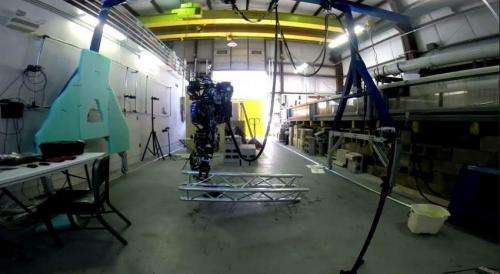September 7, 2014 weblog
MIT ATLAS robot demo shows advanced moves (w/ Video)

The bipedal robot ATLAS from MIT is moving on. Reacting to the recent video of "MIT Atlas truckin' with a truss," TechCrunch said, "We've seen the cute little guy walk, toddle, and climb over obstacles but now he can reach down, grab a heavy metal girder, and drag it around like a beast. Our little robo-monster is growing up!"
The Gizmodo header was the most fitting: "The ATLAS humanoid robot has advanced to the level of a lazy teenager." Watching the video showing the robot in action from the DARPA Robotics Challenge (DRC) team at MIT, one can appreciate the resonance of asking a teenager to take out the trash or get ready for school; ATLAS moves slowly as it drags a big object around a spacious area. Nonetheless, the significance is clear. As John Biggs wrote in TechCrunch: "This means the robot could carry differently weighted objects in each arm (a gun and a battle-ax or a baby and an adult) and can also assist in warehouses and deep inside an underground lair. It is, in short, now a humanoid robot that can do useful work." The project is part of MIT's DARPA Robotics Challenge work and the team effort includes Scott Kuindersma, Frank Permenter, and Russ Tedrake. The formal description of the video demo is "A simple demonstration of ATLAS walking using an implementation of and carrying an (unmodeled) aluminum truss."
In a paper submitted to the arXiv server earlier this year, the three authored "An Efficiently Solvable Quadratic Program for Stabilizing Dynamic Locomotion." They wrote, "We describe a whole-body dynamic walking controller implemented as a convex quadratic program. The controller solves an optimal control problem using an approximate value function derived from a simple walking model while respecting the dynamic, input, and contact constraints of the full robot dynamics. By exploiting sparsity and temporal structure in the optimization with a custom active-set algorithm, we surpass the performance of the best available off-the-shelf solvers and achieve 1kHz control rates for a 34-DOF humanoid. We describe applications to balancing and walking tasks using the simulated Atlas robot in the DARPA Virtual Robotics Challenge."
The MIT DRC team home page describes ATLAS, saying that "Articulated, sensate hands will enable Atlas to use tools designed for human use. ATLAS includes 28 hydraulically-actuated degrees of freedom, two hands, arms, legs, feet and a torso. An articulated sensor head includes stereo cameras and a laser range finder. ATLAS is powered from an off-board, electric power supply via a flexible tether." The DRC team also noted on their home page that in competition with 18 other academic and industry teams, they must enable the humanoid robot to walk over uneven terrain, climb stairs and ladders, enter and drive a small utility vehicle, handle debris and other objects, and use tools.
The DRC is a competition of robot systems and software teams that are working on robots capable of assisting humans in responding to natural and man-made disasters. It was designed to be extremely difficult. The DRC finals at the end of 2014 will require robots to attempt a circuit of consecutive physical tasks, with degraded communications between robots and their operators; the winning team will receive a $2 million prize.
More information: arxiv.org/abs/1311.1839
© 2014 Tech Xplore




















